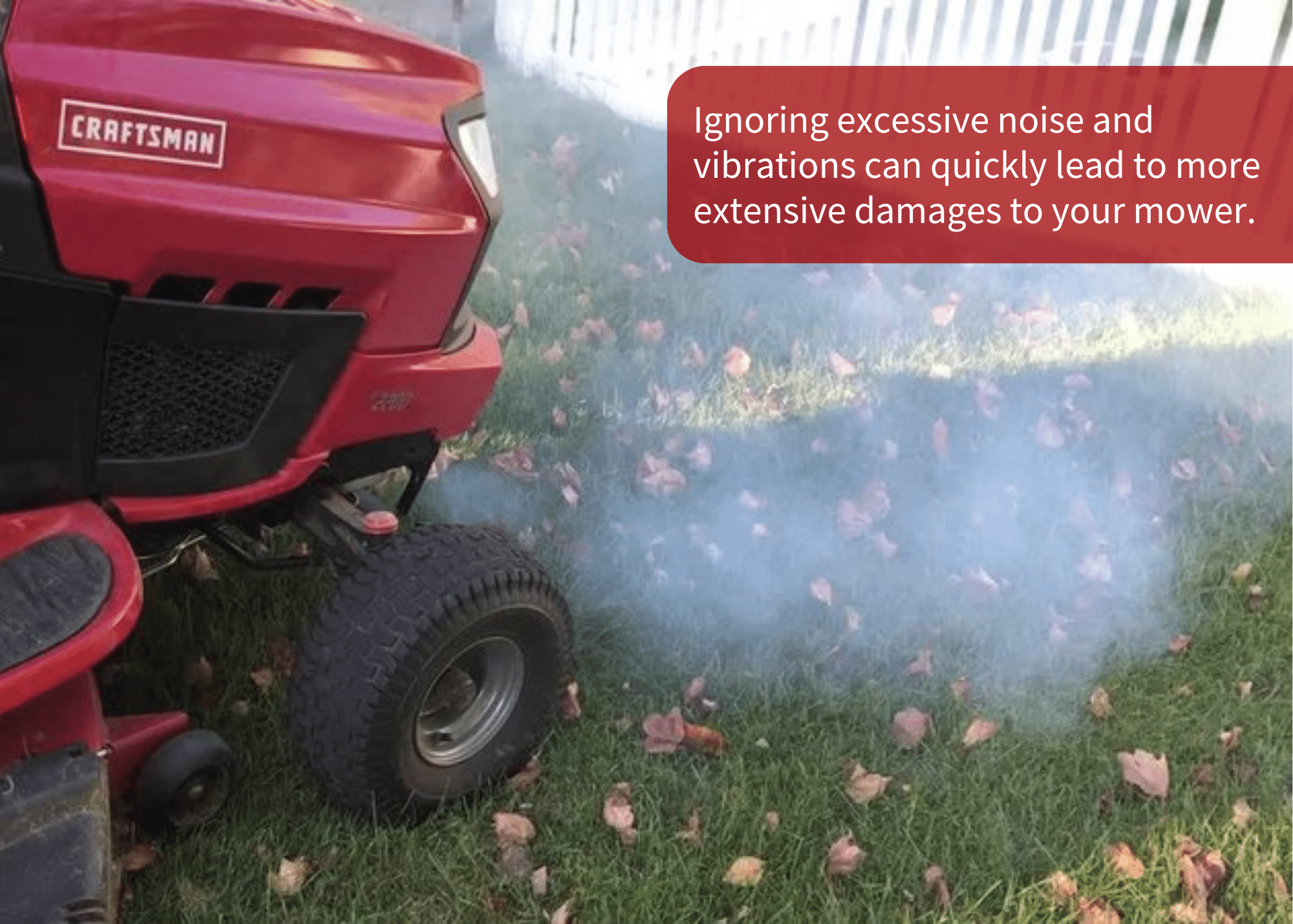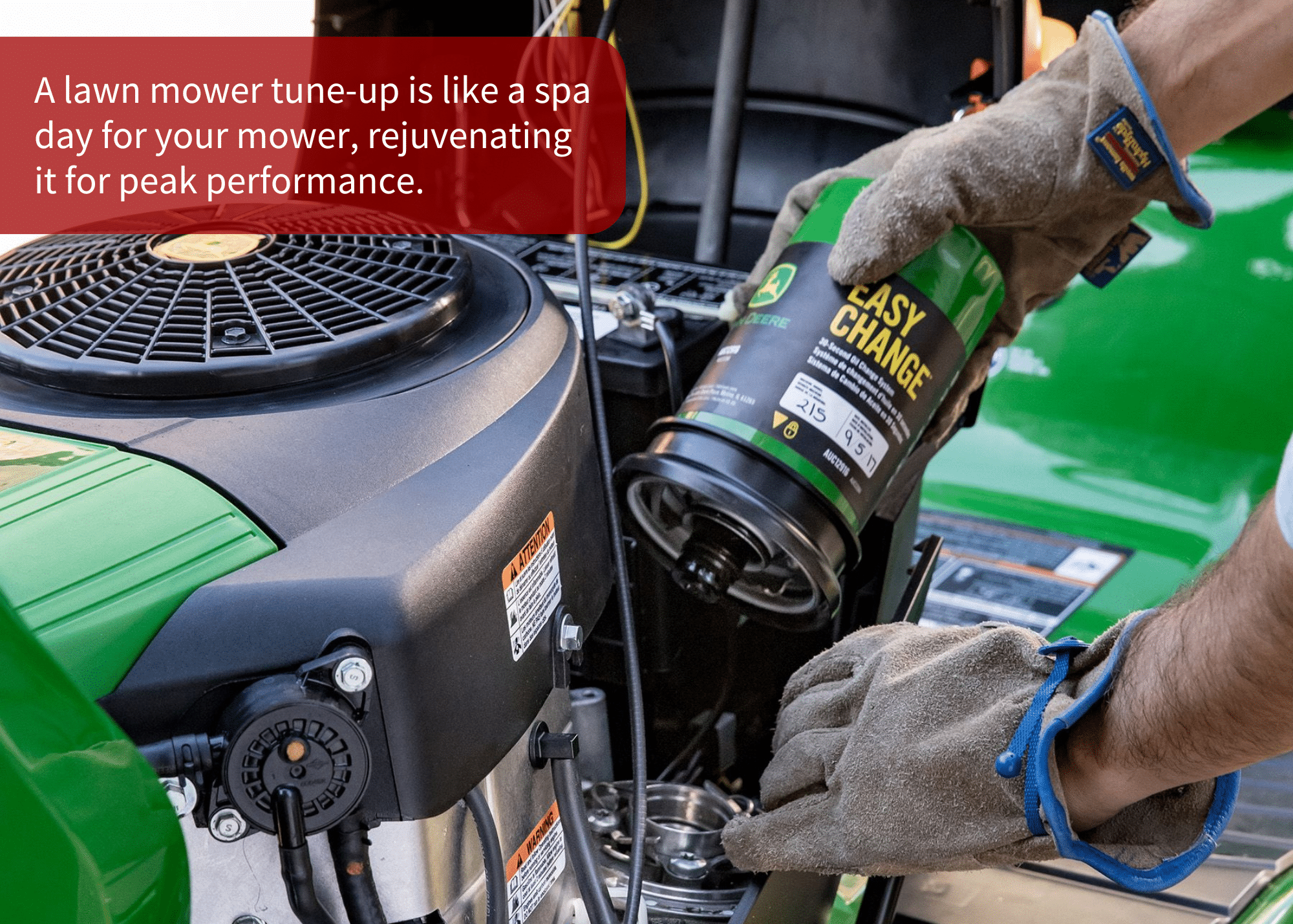Lawn Mower Maintenance:
The Key to a Healthy Lawn and Happy Mower
In the world of lush lawns and beautifully manicured landscapes, an unsung hero often goes unnoticed: the trusty lawn mower.
Whether you're a homeowner with a picturesque garden or a savvy lawn care business owner, you know that a well-maintained mower is essential for a vibrant, healthy lawn.
At SteveCo Power, we understand the crucial role that lawnmowers play in maintaining outdoor perfection. You should be able to take pride in your lawn at all times!
However, when your mower stops working, that pride can quickly fade. That's why we want to emphasize a fundamental truth: lawn mower maintenance is much more cost-effective than dealing with the repercussions of neglect.
In this article, we will explore the vital aspects of lawn mower maintenance, covering common issues, the benefits of regular tune-ups, and the serious consequences of ignoring upkeep. Our goal is to equip you with the knowledge and tools you need to keep your mowers in peak condition, ensuring a flawless cut every time.
Welcome to a world where the beauty of your lawn is matched only by the efficiency of your trusted mower.
Common Lawn Mower Issues
A well-maintained lawnmower is essential for achieving a beautifully manicured lawn. However, even the most reliable mowers can experience problems from time to time. Understanding and addressing these common issues can help you avoid unnecessary headaches and expenses in the future.
In this section, we will explore typical problems encountered with lawnmowers, focusing on engine starting difficulties, poor cutting performance, excessive noise or vibration, and concerning puffs of smoke or unusual exhaust. Let's get started.
1. Engine Starting Issues
Imagine this: it's a gorgeous, sunny Saturday morning, and you're ready to give your lawn a makeover. You pull the starter cord or turn the ignition key, and... nothing happens. It can be incredibly frustrating if the engine stubbornly refuses to start or repeatedly sputters and stalls. While many issues may necessitate taking your mower to a local service center, where experts have the tools and knowledge to properly diagnose and repair the problem, there are a few things you can check on your own before spending too much money on diagnostics.
What could be the culprits?
- Stale Fuel: Fuel has a shelf life and deteriorates with time. Stagnant fuel breaks down and loses its combustible and evaporative components, leaving behind a heavier, less effective mixture that causes starting issues and poor performance. If you suspect your fuel is stale, drain it and replace it with fresh fuel.
- Clogged Fuel Filter: A clogged fuel filter restricts clean fuel flow to the engine, causing poor performance, stalling, or failure to start. Over time, dirt and debris build up in the filter, reducing acceleration and efficiency. If left unaddressed, inadequate fuel supply reduces performance and diminishes fuel efficiency, making regular filter maintenance essential for optimal operation.
- Dirty Air Filter: Engines rely on a steady flow of air for proper combustion, and a clogged air filter restricts this airflow, leading to inefficient fuel combustion, reduced power, and poor performance. This can lead to misfiring, stalling, and overheating due to an unbalanced fuel-air mixture. Regularly inspect and replace the air filter as needed.
- Fouled Spark Plug: A fouled spark plug is typically caused by a buildup of carbon, oil, or fuel deposits on its electrodes, often due to poor-quality fuel, a clogged air filter, or other engine issues. This prevents the spark plug from creating a consistent spark, leading to starting problems and poor performance. Check and replace spark plugs at the manufacturer's recommended intervals.
- Low Oil Level: Some engines, but not all, have a low oil shut-off. This safety feature prevents the engine from running by cutting off the spark if the oil level gets too low. This prevents the engine from overheating, which can cause significant internal damage. To resolve this, check the oil level; if it's low, drain the remainder of the oil and fill it with fresh oil to the recommended level.
Of course, this is just a start. If you cannot fix your mower using these simple solutions, you may need to take it to an outdoor equipment repair shop. It's essential to address engine starting problems quickly to avoid the frustration of a mower that won't start and to prevent any further damage to the engine.

2. Poor Cutting Performance
A patchy, uneven lawn after mowing is enough to make any lawn enthusiast cringe. Poor cutting performance is a common issue with mowers, and it can result from various factors.
What could be the culprits?
- Dull Blades: Dull mower blades impact both the cutting performance and the health of your grass. Dull blades tear the grass rather than cut it cleanly, causing it to dry out, increasing vulnerability to disease, and making it more difficult to recover and thrive. Regularly sharpening mower blades ensures cleaner cuts and promotes a healthier lawn.
- Bent Blades: Mowing with a bent blade can lead to poor cutting performance and potential damage to the mower's spindles. A bent blade cuts grass unevenly, leaving behind ragged edges that can stress the lawn and make it more susceptible to disease. It's important to regularly inspect and replace bent blades to maintain optimal cutting performance.
- Uneven Deck: An uneven cutting deck can severely affect the cutting performance and result in an uneven lawn. When the deck is misaligned, it fails to cut grass uniformly, which can result in an inconsistent appearance and stress on the grass. Consult your owner's manual to adjust the deck height correctly. Replace worn parts or seek professional repair to restore proper function if necessary.
- Clogged Deck: A clogged cutting deck can significantly hinder its performance. When grass clippings and debris accumulate beneath the deck, they obstruct airflow, which is crucial for lifting and distributing the grass evenly during mowing. Insufficient airflow underneath the deck results in an inefficient cut, leaving behind clumps of grass. To prevent this, simply clean the deck regularly.
Remember, a well-maintained mower with sharp blades not only gives you a manicured lawn but also promotes a healthy lawn by preventing ragged cuts that invite disease into your lawn.
3. Excessive Noise or Vibration
Is your peaceful mowing session interrupted by unsettling noise and vibrations? Excessive noise or vibration can be more than just a nuisance; they can indicate underlying issues that need attention.
What could be the culprits?
- Loose or Damaged Blade: The uneven force of a loose or bent blade can cause excessive noise and vibrations. Bent blades will put additional strain on the spindles, causing them to wear out sooner or even break. It's important to regularly inspect and replace bent blades to protect the mower's internal components and prevent spindle failure.
- Unbalanced Blades: Sharpening mower blades is much more than just ensuring the cutting edge is razor sharp; it's also crucial to ensure they are well-balanced to ensure smooth operation and optimal cutting performance. An unbalanced blade can lead to excessive vibrations and damage the spindle bearings and other components over time.
- Spindle Failure: Worn-out spindle bearings on a mower can lead to significant performance issues. These bearings support the spindle, allowing the blades to rotate smoothly. When the bearings wear out, the spindle can wobble, causing the blades to vibrate or spin unevenly, which results in poor cutting performance and an uneven lawn.
- Engine Problems: While rare, engine-related issues, such as loose mounting bolts, a bent crankshaft, or other damaged components, can result in excessive noise and vibration. These vibrations can make the mower uncomfortable to operate and lead to premature wear on engine components, damage to the frame, and misalignment of internal parts.
Ignoring excessive noise and vibrations can quickly lead to more extensive damage to your mower and affect the overall quality of your lawn.

Smoke or Unusual Exhaust
Noticing smoke or unusual exhaust from your mower can be concerning. It indicates that something may be wrong under the hood.
What could be the culprits?
- Overfilled Oil: When an engine is overfilled with oil, the excess oil creates several issues that cause the engine to smoke. As the engine runs, the excess oil is forced into areas such as the air filter or exhaust system. This causes the oil to burn off, resulting in visible smoke. To prevent smoking and other engine damage, it's crucial to regularly check and maintain the oil at the proper level.
- Oil Contamination: When fuel leaks into the oil chamber of an engine, the mixture produces thick smoke and affects its ability to lubricate properly. This typically results from a malfunctioning carburetor or a faulty fuel pump. To repair this issue, drain and replace the contaminated oil with fresh oil and replace or repair the carburetor, fuel pump, and fuel lines as necessary.
- Air Filter Problems: The air filter supplies clean, filtered air to the engine for combustion. When the air filter becomes clogged with dirt and debris, it restricts the airflow, causing an improper air-to-fuel ratio. This leads to the engine running rich, meaning there is too much fuel and not enough air in the mixture. As a result, excess fuel burns incompletely, creating thick, black smoke from the exhaust.
- Worn or Damaged Piston Rings or Cylinder Walls: Piston rings are designed to seal the combustion chamber and prevent oil from leaking into it, where it would be burned during the engine's operation. If these rings become worn, cracked, or damaged, or the cylinder walls are scratched or scored, oil can seep past them and mix with the fuel-air mixture. This leads to oil burning during combustion, causing thick, bluish smoke to emit from the exhaust. Over time, this can significantly reduce engine performance and efficiency and increase the likelihood of further internal damage. Repairing this issue usually requires replacing the piston rings and possibly honing or reboring the cylinder walls, which can be costly. This will likely need to be diagnosed by a service shop as it takes specific tools to diagnose it. Regular maintenance can help prevent this problem.
Promptly addressing these issues is essential for both the performance of your mower and your safety, as well as for environmental responsibility.
Neglecting these common lawn mower issues can have costly consequences. In addition to the inconvenience of stalled starts, uneven cuts, unsettling noise, and alarming exhaust, the price tag of repair or replacement can be substantial. While routine maintenance may seem like a small task, it is a worthwhile investment in the longevity of your mower and the quality of your lawn.
Next, we'll explore the importance of preventive maintenance and how it can save you time, money, and a lot of hassle. Your lawn and your wallet will thank you.
How to Avoid Lawn Mower Issues With Tune-Ups
Now that you've learned about the common issues that can affect lawnmowers, let's explore the preventative benefits of lawnmower tune-ups.
If you're feeling a bit overwhelmed, don't worry. We'll clarify the process by breaking down what a lawn mower tune-up involves and highlighting the numerous benefits regular maintenance provides for your reliable mower.
1. What a Lawn Mower Tune-Up Entails
A lawn mower tune-up is like a spa day for your mower, rejuvenating it for peak performance. The key components of a complete tune-up include:
1. Inspection of Key Components:
- Meticulously examine the engine mounting bolts, the engine cooling fins, and the transmission cooling fins, if applicable.
- Remove and inspect the spark plugs, the air filter, and the fuel system.
- Inspect the condition and levels of the engine oil and the transmission or hydraulic fluid, if applicable.
- Inspect the condition of the belts for tears or dry-rotting conditions.
- Inspect and identify signs of deteriorating bearings in the idler pulleys and blade spindles.
- If applicable, inspect the electrical connections and battery for signs of corrosion or loose connections.
- Assess the mower deck and blades for proper alignment and condition.
- Inspect the tire conditions and treads to ensure optimal traction.
2. Cleaning and Lubrication:
- Remove any dirt, grass clippings, and debris from the engine cooling fins, the transmission fins, and around the deck pulleys.
- Remove all the dirt and debris that accumulated underneath the cutting deck.
- Lubricate moving components like bearings, bushings, and any high-friction areas with grease zerks to reduce friction and wear.
- Remove and clean any electrical components that display signs of rust or corrosion.
- Clean, sharpen, and balance the blades.
3. Replacing Worn Parts:
- Replace dirty air and fuel filters, as well as discolored spark plugs.
- Replace any parts that show signs of wear or damage, such as belts, idler pulleys, spindle bearings, and blades.
- Drain the old, used oil from the engine and replace it with fresh oil. If applicable, replace the oil filter.
- Replace any electrical components that show signs of damage beyond repair.
4. Adjusting Settings:
- Fine-tune critical settings, such as the throttle and the carburetor, for optimal engine performance.
- Verify that all of the safety features are in perfect working condition.
- Adjust the cutting height and the tire pressures to ensure an even, precise cut.

Benefits of Regular Tune-Ups
Now that we've dissected the elements of a lawn mower tune-up, let's explore the numerous benefits this maintenance routine offers:
1. Improved Performance and Efficiency:
- A finely tuned mower starts reliably, runs smoothly, and delivers consistent power.
- Precise adjustments enhance fuel combustion, resulting in cleaner exhaust and reduced emissions.
- Your mower's cutting performance becomes more efficient, leaving your lawn with a pristine finish.
2. Prolonged Mower Lifespan:
- Regular tune-ups extend the life of your mower's engine and components.
- Identifying and addressing issues early prevents them from escalating into costly problems.
- Investing in maintenance now can save you from the expense of frequent repairs or the need for premature replacement.
3. Reduced Fuel Consumption:
- A well-maintained mower operates more efficiently, consuming less fuel.
- Consistent fuel efficiency not only saves you money at the gas pump but also reduces your carbon footprint.
4. Enhanced Safety:
- A well-maintained mower is a safer mower.
- Adjustments to safety features provide peace of mind during operation.
- Reduced vibration and noise levels create a more comfortable and safe mowing experience.
In a world where prevention is often more cost-effective than addressing problems after they arise, regular lawnmower tune-ups emerge as the unsung heroes of lawn care. Whether you're a dedicated homeowner passionate about maintaining a lush lawn or a lawn-care business owner seeking efficiency and reliability, prioritizing maintenance is the key to a greener and more prosperous future.
In the next section, we'll explore the consequences of neglecting mower maintenance, highlighting the potential pitfalls that await those who overlook the importance of regular maintenance. So stay with us on this journey toward a healthier, happier, and more vibrant lawn. Your mower and your lawn will greatly appreciate it.

The Consequences of Neglecting Maintenance
Ignoring lawnmower maintenance is like turning a blind eye to an impending storm. You might not see it coming, but when it hits, the consequences can be devastating. Neglecting your mower can lead to expensive repairs, a reduced lifespan, an unhealthy lawn, and excessive fuel consumption, all of which can have significant consequences.
Potential Consequences of Neglecting Lawn Mower Maintenance
1. Expensive Repairs:
Neglecting regular maintenance can turn minor issues into major repairs that drain your wallet. For example, ignoring a strange noise or vibration can lead to an expensive engine overhaul or could result in the need for a complete engine replacement later on.
2. Reduced Mower Lifespan:
Mowers that are not well-maintained tend to have shorter lifespans. When components are not regularly inspected, cleaned, and lubricated, wear and tear accumulate more quickly. This premature aging of your mower means you may have to invest in a new one sooner than expected.
3. Unhealthy Lawn Conditions:
As we noted before, neglected mowers with dull blades, clogged cutting decks, and other worn cutting components harm your lawn's health. Dull blades tear the grass rather than cut it cleanly, causing it to dry out, increasing vulnerability to disease, and making it more difficult to recover and thrive.
4. Excessive Fuel Consumption:
Mowers that aren't well-maintained typically consume more fuel, making them less efficient than their properly cared-for counterparts. Higher fuel consumption leads to increased greenhouse gas emissions, contributing to environmental pollution. Conserving fuel benefits your wallet and helps reduce your ecological footprint.

As we move forward, we'll explore practical and effective methods for establishing a lawn mower maintenance routine that guarantees your mower's durability, efficiency, and safety.
Do you need help determining which type of mower you want to invest in? Make sure to check out our other practical blogs:
Lawn Mower Maintenance Checklist
1. Cleaning the Mower Deck:
- Start by disconnecting the sparkplug(s) to ensure your safety.
- Remove the grass clippings, dirt, and debris from the mower deck using a brush or scraper.
- Rinse the deck with a garden hose and dry it thoroughly to prevent corrosion.
2. Sharpening or Replacing the Blades:
- Remove the mower blade(s) and carefully inspect for damage or wear.
- Clean, sharpen, and balance the blade(s) or replace them if necessary.
- Reattach the blade(s) securely.
3. Replacing the Spark Plugs and Air Filter:
- Remove and inspect the sparkplug(s) and air filter for signs of wear, damage, or excess dirt.
- If necessary, replace the sparkplug(s) and air filter with new, compatible ones.
- Refer to your mower's manual for specific details.
- Consult your mower's manual for the appropriate oil type and replacement intervals.
- Position an oil pan beneath the drain plug and remove the plug to drain the old oil.
- If applicable, replace the oil filter.
- Refill with fresh, clean oil to the recommended level.
5. Checking the Fuel System and Lines:
- If applicable, remove and replace the fuel filter.
- Inspect the fuel tank for debris or contaminants and clean it if necessary.
- Examine the fuel lines and connections for leaks or damage.
- Ensure that the fuel cap is secure and functioning correctly.
6. Inspecting the Belts and Pulleys:
- Check the belts for signs of wear, cracks, or fraying.
- Inspect the pulleys for damage, misalignment, or bad bearings.
- Tighten or replace the belts and pulleys as necessary.
7. Testing the Safety Features:
- Ensure the safety features are functioning correctly.
- Test the mower's drive system and blade engagement mechanisms for smooth operation.
- Ensure the throttle and governor settings are adjusted to the manufacturer's specifications.

Downloadable/Printable Version for Your Convenience
To make your life easier, we are providing you with a downloadable and printable version of our comprehensive lawn mower maintenance checklist. Whether you prefer a digital reference or a hard copy to hang in your workshop, this checklist can be your go-to resource for ensuring your mower's longevity, performance, and safety.
With this checklist in hand (or on your screen), you'll feel confident tackling mower maintenance like a pro. Remember, a well-maintained mower not only guarantees a pristine lawn but also saves you time, money, and the hassle of unexpected breakdowns.
Conclusion
We've uncovered the critical importance of regular lawnmower tune-ups, examined the serious consequences of neglecting maintenance, and provided you with a detailed maintenance checklist. Now, let's summarize our key points.
In a nutshell, here's what you need to remember:
- Regular lawnmower maintenance is the cornerstone of a lush, healthy lawn, ensuring your mower will stand the test of time.
- Neglecting maintenance can result in costly repairs, a shorter lifespan for your mower, and health hazards for your lawn.
- Our detailed maintenance checklist provides you with the tools and knowledge necessary to keep your lawnmower in pristine condition.
Taking the Time Now Saves You Hundreds of Dollars in the Future!
The message couldn't be clearer: prevention is better than the cure. Routine lawnmower tune-ups are the key to avoiding the hassle and expense of unexpected repairs. Whether you're a dedicated homeowner or a lawn care business owner, a well-maintained mower will perform better, last longer, and operate more efficiently.
Neglecting lawn mower maintenance goes beyond mere inconvenience; it can be a costly risk. The potential for expensive repairs and an unhealthy lawn highlight the far-reaching consequences of neglect.
Let Us Help You
At SteveCo Power, we are dedicated to empowering you with the knowledge, resources, and tools you need to succeed in lawnmower maintenance. We invite you to start your maintenance routine today and let us guide you toward a greener, more prosperous lawn.
We offer a range of services, including:
Our expert team is ready to assist you in keeping your mower in top condition.
If you have maintenance tips or success stories to share, we'd love to hear from you. Your experiences can inspire and educate others.
And if you enjoyed this article, be sure to check out others on our blog. You can also stay updated by following us on Facebook and Instagram.
Remember, a flourishing lawn begins with a well-maintained mower, and SteveCo Power is your partner on this journey. Here's to a future filled with perfectly manicured lawns, efficient mowers, and the satisfaction of a job well done. Until next time, happy mowing!
